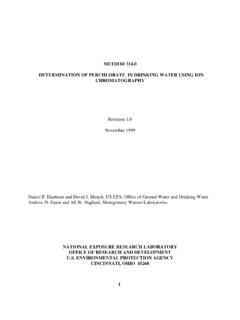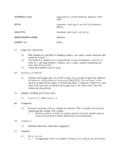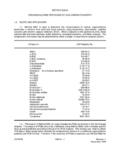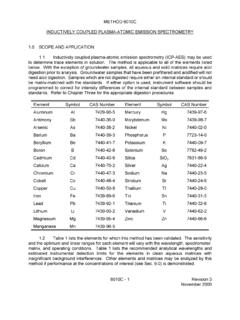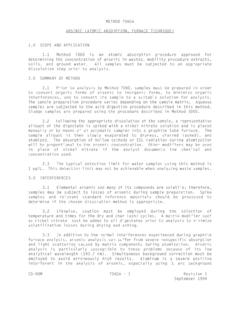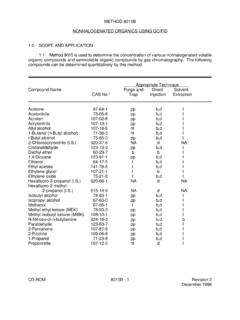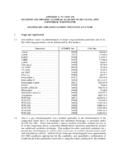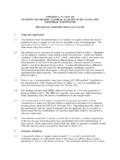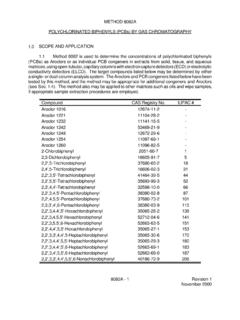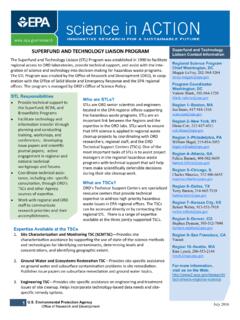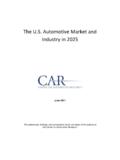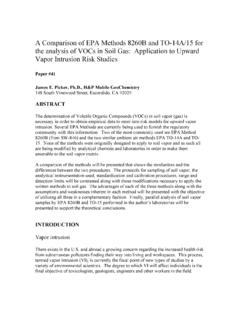Transcription of EPA Document #: EPA/600/R-08/092 METHOD 537. …
1 537-1 EPA Document #: EPA/600/R-08/092 METHOD 537. determination OF selected perfluorinated alkyl ACIDS IN DRINKING WATER BY SOLID PHASE EXTRACTION AND LIQUID CHROMATOGRAPHY/TANDEM MASS SPECTROMETRY (LC/MS/MS) Version September 2009 Shoemaker US EPA, Office of Research and Development, National Exposure Research Laboratory Grimmett US EPA, Office of Research and Development, National Exposure Research Laboratory Boutin The National Council on Aging, Senior Environmental Employment Program NATIONAL EXPOSURE RESEARCH LABORATORY OFFICE OF RESEARCH AND DEVELOPMENT U. S. ENVIRONMENTAL PROTECTION AGENCY CINCINNATI, OHIO 45268 537-2 METHOD 537 determination OF selected perfluorinated alkyl ACIDS IN DRINKING WATER BY SOLID PHASE EXTRACTION AND LIQUID CHROMATOGRAPHY/TANDEM MASS SPECTROMETRY (LC/MS/MS) 1.
2 SCOPE AND APPLICATION This is a liquid chromatography/tandem mass spectrometry (LC/MS/MS) METHOD for the determination of selected perfluorinated alkyl acids (PFAAs) in drinking water. Accuracy and precision data have been generated in reagent water, and finished ground and surface waters for the compounds listed in the table below. Analyte Acronym Chemical Abstract Services Registry Number (CASRN) N-ethyl perfluorooctanesulfonamidoacetic acid NEtFOSAA N-methyl perfluorooctanesulfonamidoacetic acid NMeFOSAA Perfluorobutanesulfonic acid PFBS 375-73-5 Perfluorodecanoic acid PFDA 335-76-2 Perfluorododecanoic acid PFDoA 307-55-1 Perfluoroheptanoic acid PFHpA 375-85-9 Perfluorohexanesulfonic acid PFHxS 355-46-4 Perfluorohexanoic acid PFHxA 307-24-4 Perfluorononanoic acid PFNA 375-95-1 Perfluorooctanesulfonic acid PFOS 1763-23-1 Perfluorooctanoic acid PFOA 335-67-1 Perfluorotetradecanoic acid PFTA 376-06-7 Perfluorotridecanoic acid PFTrDA 72629-94-8 Perfluoroundecanoic acid PFUnA 2058-94-8 The Minimum Reporting Level (MRL) is the lowest analyte concentration that meets Data Quality Objectives (DQOs) that are developed based on the intended use of this METHOD .
3 The single laboratory lowest concentration MRL (LCMRL) is the lowest true concentration for which the future recovery is predicted to fall, with high confidence (99%), between 50 and 150% recovery. Single laboratory LCMRLs for analytes in this METHOD range from ng/L, and are listed in Table 5. The procedure used to determine the LCMRL is described 537-3 Laboratories using this METHOD will not be required to determine the LCMRL for this METHOD , but will need to demonstrate that their laboratory MRL for this METHOD meets the requirements described in Section Determining the Detection Limit (DL) for analytes in this METHOD is optional (Sect. ). Detection limit is defined as the statistically calculated minimum concentration that can be measured with 99% confidence that the reported value is greater than The DL is compound dependent and is dependent on extraction efficiency, sample matrix, fortification concentration, and instrument performance.
4 This METHOD is intended for use by analysts skilled in solid phase extractions, the operation of LC/MS/MS instruments, and the interpretation of the associated data. METHOD FLEXIBILITY In recognition of technological advances in analytical systems and techniques, the laboratory is permitted to modify the evaporation technique, separation technique, LC column, mobile phase composition, LC conditions and MS and MS/MS conditions (Sect. , , , and ). Changes may not be made to sample collection and preservation (Sect. 8), the sample extraction steps (Sect. 11), or to the quality control requirements (Sect. 9). METHOD modifications should be considered only to improve METHOD performance. Modifications that are introduced in the interest of reducing cost or sample processing time, but result in poorer METHOD performance, should not be used. Analytes must be adequately resolved chromatographically in order to permit the mass spectrometer to dwell on a minimum number of compounds eluting within a retention time window.
5 Instrumental sensitivity (or signal-to-noise) will decrease if too many compounds are permitted to elute within a retention time window. In all cases where METHOD modifications are proposed, the analyst must perform the procedures outlined in the initial demonstration of capability (IDC, Sect. ), verify that all Quality Control (QC) acceptance criteria in this METHOD (Sect. 9) are met, and that acceptable METHOD performance can be verified in a real sample matrix (Sect. ). NOTE: The above METHOD flexibility section is intended as an abbreviated summation of METHOD flexibility. Sections 4-12 provide detailed information of specific portions of the METHOD that may be modified. If there is any perceived conflict between the general METHOD flexibility statement in Section and specific information in Sections 4-12, Sections 4-12 supersede Section 2. SUMMARY OF METHOD A 250-mL water sample is fortified with surrogates and passed through a solid phase extraction (SPE) cartridge containing polystyrenedivinylbenzene (SDVB) to extract the METHOD analytes and surrogates.
6 The compounds are eluted from the solid phase with a small amount of methanol. The extract is concentrated to dryness with nitrogen in a heated water bath, and then adjusted to a 1-mL volume with 96:4% (vol/vol) methanol:water after adding the IS(s). A 10- L injection is made into an LC equipped with a C18 column that is interfaced to an MS/MS. The analytes are separated and 537-4 identified by comparing the acquired mass spectra and retention times to reference spectra and retention times for calibration standards acquired under identical LC/MS/MS conditions. The concentration of each analyte is determined by using the internal standard technique. Surrogate analytes are added to all Field and QC Samples to monitor the extraction efficiency of the METHOD analytes. 3. DEFINITIONS ANALYSIS BATCH A set of samples that is analyzed on the same instrument during a 24-hour period, including no more than 20 Field Samples, that begins and ends with the analysis of the appropriate Continuing Calibration Check (CCC) standards.
7 Additional CCCs may be required depending on the length of the analysis batch and/or the number of Field Samples. CALIBRATION STANDARD (CAL) A solution prepared from the primary dilution standard solution and/or stock standard solution, internal standard(s), and the surrogate(s). The CAL solutions are used to calibrate the instrument response with respect to analyte concentration. COLLISIONALLY ACTIVATED DISSOCIATION (CAD) The process of converting the precursor ion s translational energy into internal energy by collisions with neutral gas molecules to bring about dissociation into product ions. CONTINUING CALIBRATION CHECK (CCC) A calibration standard containing the METHOD analytes, internal standard(s) and surrogate(s). The CCC is analyzed periodically to verify the accuracy of the existing calibration for those analytes. DETECTION LIMIT (DL) The minimum concentration of an analyte that can be identified, measured, and reported with 99% confidence that the analyte concentration is greater than zero.
8 This is a statistical determination of precision (Sect. ), and accurate quantitation is not expected at this EXTRACTION BATCH A set of up to 20 Field Samples (not including QC samples) extracted together by the same person(s) during a work day using the same lot of SPE devices, solvents, surrogate, internal standard and fortifying solutions. Required QC samples include Laboratory Reagent Blank, Laboratory Fortified Blank, Laboratory Fortified Sample Matrix, and either a Field Duplicate or Laboratory Fortified Sample Matrix Duplicate. FIELD DUPLICATES (FD1 and FD2) Two separate samples collected at the same time and place under identical circumstances, and treated exactly the same throughout field and laboratory procedures. Analyses of FD1 and FD2 give a measure of the precision associated with sample collection, preservation, and storage, as well as laboratory procedures. 537-5 FIELD REAGENT BLANK (FRB) An aliquot of reagent water that is placed in a sample container in the laboratory and treated as a sample in all respects, including shipment to the sampling site, exposure to sampling site conditions, storage, preservation, and all analytical procedures.
9 The purpose of the FRB is to determine if METHOD analytes or other interferences are present in the field environment. INTERNAL STANDARD (IS) A pure chemical added to an extract or standard solution in a known amount(s) and used to measure the relative response of other METHOD analytes and surrogates that are components of the same solution. The internal standard must be a chemical that is structurally similar to the METHOD analytes, has no potential to be present in water samples, and is not a METHOD analyte. LABORATORY FORTIFIED BLANK (LFB) A volume of reagent water or other blank matrix to which known quantities of the METHOD analytes and all the preservation compounds are added in the laboratory. The LFB is analyzed exactly like a sample, and its purpose is to determine whether the methodology is in control, and whether the laboratory is capable of making accurate and precise measurements.
10 LABORATORY FORTIFIED SAMPLE MATRIX (LFSM) A preserved field sample to which known quantities of the METHOD analytes are added in the laboratory. The LFSM is processed and analyzed exactly like a sample, and its purpose is to determine whether the sample matrix contributes bias to the analytical results. The background concentrations of the analytes in the sample matrix must be determined in a separate sample extraction and the measured values in the LFSM corrected for background concentrations. LABORATORY FORTIFIED SAMPLE MATRIX DUPLICATE (LFSMD) A duplicate of the Field Sample used to prepare the LFSM. The LFSMD is fortified, extracted, and analyzed identically to the LFSM. The LFSMD is used instead of the Field Duplicate to assess METHOD precision when the occurrence of METHOD analytes is low. LABORATORY REAGENT BLANK (LRB) An aliquot of reagent water or other blank matrix that is treated exactly as a sample including exposure to all glassware, equipment, solvents and reagents, sample preservatives, internal standard, and surrogates that are used in the analysis batch.
